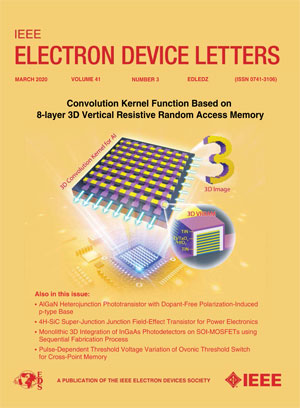基于VGSOT-MTJ的全并行自旋更新可重构机p位单元
IF 4.5
2区 工程技术
Q2 ENGINEERING, ELECTRICAL & ELECTRONIC
引用次数: 0
摘要
基于磁隧道结(MTJ)的基于自旋的概率比特(p-bit)为构建高性能磁隧道结(IM)提供了一种低功耗、低开销的解决方案。在这项工作中,我们提出了一种新的p位器件,该器件集成了由自旋轨道扭矩(SOT)电压偏置的电压控制磁各向异性(VCMA) MTJ。所提出的p位每次操作的能耗约为33fJ/bit。利用该装置的同步Ising网络在模拟中解决${13}\ ×{26}$顶点的最大切割问题时,显示出快速收敛到近基态解决方案。此外,通过MTJ阵列的耦合实现了可重构的IM架构,使全自旋Ising系统能够解决各种组合优化问题(cop)。所提出的IM系统在多个可逆布尔逻辑门之间也具有功能可重构性,峰值精度达到95%。这些结果突出了所提出的p位作为高速,低功耗和通用Ising机器的有前途的构建块的潜力。本文章由计算机程序翻译,如有差异,请以英文原文为准。
A Novel P-bit Unit Based on VGSOT-MTJ for Reconfigurable Ising Machine With Fully Parallel Spin Updating Design
The spin-based probabilistic bit (p-bit) built on magnetic tunnel junction (MTJ) provides a low power and low overhead solution for building high performance Ising machine (IM). In this work, we propose a novel p-bit device that integrates a voltage-controlled magnetic anisotropy (VCMA) MTJ biased by spin-orbit torque (SOT) voltage. The proposed p-bit achieves an energy consumption of approximately 33fJ/bit per operation. A synchronous Ising network utilizing this device demonstrates rapid convergence to near-ground-state solutions when solving a ${13}\times {26}$ -vertex Max-Cut problem in simulation. Furthermore, a reconfigurable IM architecture, realized through the coupling of MTJ array, enables an all-spin Ising system capable of addressing various combinatorial optimization problems (COPs). The proposed IM system also exhibits functional reconfigurability among multiple invertible Boolean logic gates, achieving a peak accuracy of 95%. These results highlight the potential of the proposed p-bit as a promising building block for high-speed, low-power and universal Ising machines.
求助全文
通过发布文献求助,成功后即可免费获取论文全文。
去求助
来源期刊

IEEE Electron Device Letters
工程技术-工程:电子与电气
CiteScore
8.20
自引率
10.20%
发文量
551
审稿时长
1.4 months
期刊介绍:
IEEE Electron Device Letters publishes original and significant contributions relating to the theory, modeling, design, performance and reliability of electron and ion integrated circuit devices and interconnects, involving insulators, metals, organic materials, micro-plasmas, semiconductors, quantum-effect structures, vacuum devices, and emerging materials with applications in bioelectronics, biomedical electronics, computation, communications, displays, microelectromechanics, imaging, micro-actuators, nanoelectronics, optoelectronics, photovoltaics, power ICs and micro-sensors.
 求助内容:
求助内容: 应助结果提醒方式:
应助结果提醒方式:


